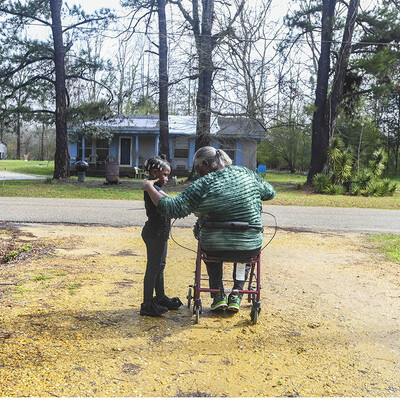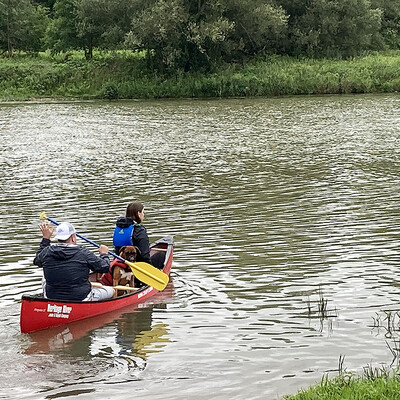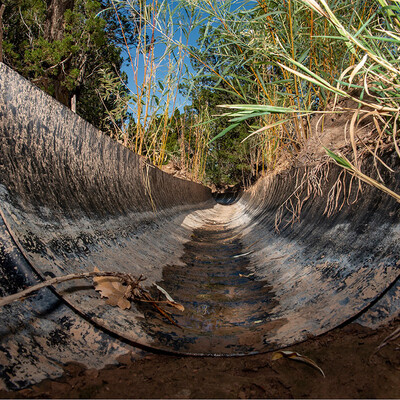Rural New Mexicans meet drought with culture of water sharing
Loading...
| Placitas, N.M.
Acequia is the name for a kind of irrigation ditch that rural people rely on to water their farms or orchards in arid New Mexico. But it is also something more.
“An acequia is a community of people,” says Paula Garcia, executive director of the New Mexico Acequia Association. “You have your right to the water, but you also have your responsibilities to the community.”
Why We Wrote This
Drought and climate change pose new challenges to New Mexico’s water supply. But a tradition of shared access – based around irrigation ditches called acequias – continues to thrive.
The system includes centuries-old traditions like the mayordomo, the person elected every few years to manage how much water gets shared and when, and a communal spring cleaning of the ditches.
But climate change means water may grow more scarce. In the community of Placitas this summer, the mayordomo has cut irrigating back from once a week, to once every two weeks, to now once every three weeks.
Ms. Garcia says the water networks are well placed to help New Mexico navigate a drier, thirstier future. Of the roughly 640 acequias in the state, she notes, about 200 of them are improving their infrastructure. She says “they’re not in a state of decline at all. What I’ve observed in the last [few decades] is a resurgence in interest.”
Carolyn Kennedy can’t hurdle the ditch like she used to. So, on a warm August afternoon, she’s limping home with a twisted ankle.
Muddy and narrow, the ditch – known as an acequia – snakes up the northern slope of the Sandia Mountains in rugged ‘s’ bends. In the three centuries the village of Placitas has occupied these dusty orange hills, the acequia has barely changed. It’s one of the things Ms. Kennedy loves most about it.
But not everything is the same, she acknowledges as she settles into a green couch in the cottage she’s called home for about five decades.
Why We Wrote This
Drought and climate change pose new challenges to New Mexico’s water supply. But a tradition of shared access – based around irrigation ditches called acequias – continues to thrive.
“There used to be water in the ditch all the time,” she says. And not just that, but peach trees, apple orchards, and other produce locals would sell to make a little extra money.
As the rest of the world adopted new water storage and irrigation technologies, these hand-dug and gravity-fed trenches have remained an economic and cultural lifeline for rural New Mexico. In fact they are part of a long line of communities and civilizations to rely on acequias – and, broadly, acequia culture – to survive in some of the planet’s most inhospitable climates.
Acequia managers in New Mexico fought for years in courtrooms and legislative offices to carve a place for themselves as water rights became increasingly privatized. Today, as megadrought and economic development ramp up pressure on the roughly 640 acequias in the state, they see their ancient, community-driven approach to water management as more threatened – but more valuable – than ever.
“Acequias have learned long ago to be able to share the water – what there is,” says Ms. Kennedy. “That’s what we do here. We share what little there is as best we can.”
Mainstream appeal in an era of change
Across the living room in their cottage, her husband, Lynn Montgomery – a self-proclaimed “desert rat” and “activist hippie” – is sitting on a silver exercise ball. He’s been through some bad droughts, including two in the past three years. He’s been watching as snowmelt, the primary water source for his acequias, continues a long-term decline.
Still, he believes that this gritty subculture not only has to endure the state’s increasingly dry future, but has to re-enter the mainstream.
“I’m into turning everybody into an acequia person in the state,” he says. “That’s what we have to do.”
The idea may not be outlandish, given the support this culture has found in the past.
Acequias – pronounced ah-SEH-kee-ahs – were developed over thousands of years in the Middle East and North Africa. (The word “acequia” is derived from the Arabic term al-sāqiya, meaning “one that gives water.”) They were so effective at irrigating crop land in Spain that when King Jaime I recaptured the city of Valencia from the Moors in 1238, he kept in place the network of gravity-fed irrigation ditches the Muslims had installed.
Almost 400 years later, the first Spanish settlers arrived in New Mexico. Eyeing up the dry, arid hills, and taking some inspiration from the local Indigenous population, the colonists constructed acequias as they sought to settle and populate the colony. By 1848, as the region neared becoming an official U.S. territory, Brig. Gen. Stephen Kearny – like the Spanish king centuries earlier – ordered that the existing acequia systems not be disturbed.
A culture shaped by topography
Acequias existed throughout the Spanish empire – including modern cities like Los Angeles, Tucson, and San Antonio – but they persisted in New Mexico because, with the rugged geography, large-scale development couldn’t take hold.
“It was not economically feasible for large scale-agriculture,” says José Rivera, a professor at the University of New Mexico and author of “Acequia Culture: Water, Land, and Community in the Southwest.”
“That’s how they survived.”
Acequias in New Mexico are now used only for irrigation, but the term “acequia” refers to much more than the physical – and often modest – infrastructure itself. It’s also a name for the community that uses the canal, and the worldview that it requires of them.
“An acequia is a community of people,” says Paula Garcia, executive director of the New Mexico Acequia Association. “You have your right to the water, but you also have your responsibilities to the community.”
“You learn from an acequia how to work together, to care for the water, to deal with ... moving water across the landscape together,” she adds.
This includes centuries-old traditions like the mayordomo, the person elected every few years to manage how much water gets shared through the acequia and when, and the limpiando, when the community descends on the ditch for an annual “spring cleaning.”
Acequias, as communities, have been effective political and legal operators over the years – and in the U.S. Southwest, where water rights are everything, that has been crucial to their survival. It has kept water rights from being sold out from under them, and from new development drinking communities dry.
“Acequias are still managed as they were centuries ago,” Ms. Garcia says. “What we see [now] is acequias are working hard to continue to exist and to be viable and to contribute to a thriving community.”
An age-old system that is also up for renewal
Indeed, alongside tradition there has been innovation.
In Placitas, this has taken the form of electronic meters – not eyeballs – tracking water levels in tanks the acequia feeds for domestic water use. In Albuquerque, and on a larger scale, this has taken the form of the Middle Rio Grande Conservancy District (MRGCD).
While rampant urbanization – and the privatization of water rights – diminished the presence of acequias in cities across the West, they have remained fairly robust in Albuquerque thanks to the MRGCD. Created in 1923 to help restore the city’s watershed following decades of development and deforestation upstream, it manages 1,200 miles of waterways – including many acequias, which have self-governance but also irrigate from water legally owned by the MRGCD.
“We depend on them and they depend on us,” says Enrique Lamadrid, a comisionado (a kind of deputy mayordomo) of the Alamos de Gallegos acequia in north Albuquerque. “It’s a really great kind of symbiotic relationship.”
Indeed, in a desert city of golf courses and sprawling subdivisions, where water flows from faucets on command, acequias see themselves as a necessary champion of sustainability. For the average person walking through downtown Albuquerque, it may be hard to see that snowpack in the state has been below average for two decades now, or that, according to one study, the state is experiencing its worst drought since the late 1500s.
But it’s not hard for Mr. Lamadrid. In a good year, his acequia can water homes from spring through mid-October. This year, their water arrived in late May and disappeared in late July.
“It’s more than the historic [drought] cycles,” he says. “We are talking about something long term. We’re bracing for it, we’re planning for it.”
“The resilience is here, the experience is here. The experience goes clear back at least 1,000 years,” he adds, to Indigenous peoples who lived in the Rio Grande floodplain.
“The technology is there,” he continues. But “do people have the will to deal with the drought?”
Cutting back as water grows scarce
Now elderly and mustachioed, Bert De Lara has spent his whole life in Placitas – a village his family helped found. One of his earliest memories was watching his family’s big apple orchard succumb to a severe drought in the 1950s. Seven decades later, another drought hit in 2018, and residents were only able to use drinking water in the mornings and evenings.
“It was inconvenient, but people understood. And they were pretty good about it,” he says. “So we got through it.”
In Placitas this summer, the water meters have helped maintain a small but steady flow of water through the acequias – though their mayordomo has cut irrigating back from once a week, to once every two weeks, to now once every three weeks.
“This summer we’ve been holding our own,” says Mr. De Lara. But “there’s lots of houses around, and you can only support so many.”
Indeed, as the snowpack has dwindled, the number of new adobe houses in the burnt orange foothills of the Sandia Mountains has grown. Unlike most acequias in the state, the Placitas acequia is used for both irrigation and domestic use, but these newer residents aren’t legally allowed to draw water from it, because of a two-decade moratorium. Yet with a lack of access to the acequia comes a lack of access to the culture of stewardship and responsibility to water it engenders.
New development and industry – the legalization of recreational marijuana this year has put an added strain on water – as well as an aging generation of acequia managers are all concerns for people like Ms. Garcia.
But particularly given their centuries-long track record of surviving on minimal resources, she thinks acequias are well placed to help New Mexico navigate a drier, thirstier future. Out of the roughly 640 acequias in the state, she notes, about 200 of them are improving their infrastructure.
“Acequias are taking on some of these challenges in really tangible ways,” she says. “They’re not in a state of decline at all. What I’ve observed in the last [few decades] is a resurgence in interest.”
This resurgence ranges from infrastructure improvements, to court battles people like Mr. Montgomery have led to protect ground and surface water rights for acequias, to a program the NMAA has run since 2005 teaching younger generations about acequia management and culture.
And while there will be many hard summers ahead, as long as that knowledge is passed down, Mr. Montgomery is confident acequias will continue to endure.
“We have generations and generations of experience, suffering loss and being able to overcome it,” says Mr. Montgomery.
“That’s how we have survived through the years,” he adds. “The resilience of acequia communities is that they’re communities.”
Editor's note: This article has been updated with the pronunciation of acequias and clarifications about the Placitas acequia.















